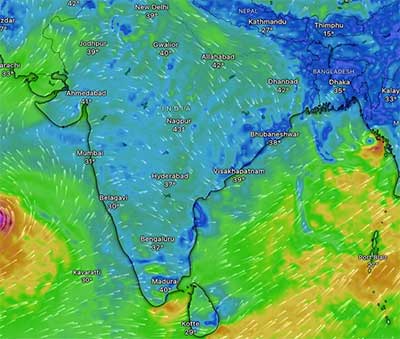Date : 09/06/2023
Relevance : GS Paper 1 : Global Warrming and Mansoon
Main Words : EL-NINO, Cyclone Biparjoy, Cyclone Mocha,Typhoon Mawar, Global warming
Context -
- The influence of global warming on cyclonic activity over the Pacific and North Indian Oceans, as well as the warming of the North Indian Ocean itself, has introduced new complexities to the dynamics of the monsoon season.
- The occurrence of pre-monsoon cyclones and typhoons has shifted closer to the monsoon onset, potentially due to the impact of a warmer Arctic Ocean on winds over the Arabian Sea.
- The monsoon's behavior is also affected by the Indian, Atlantic, and Pacific oceans, as well as atmospheric and oceanic connections with the Southern Ocean.
Understanding some terminologies -
- Cyclone: A cyclone is a large air mass that rotates around a strong center of low atmospheric pressure, counterclockwise in the Northern Hemisphere and clockwise in the Southern Hemisphere.
- Typhoon : A typhoon is a tropical cyclone that develops between 180° and 100°E in the Northern Hemisphere
- Mansoon trough : The monsoon trough is a low-pressure region that is a characteristic feature of the monsoons
Cyclone Position and Its Importance:
- The positioning of cyclones in the North Indian Ocean can have both positive and negative effects on the monsoon onset.
- Since cyclonic winds circulate counterclockwise, the location of a cyclone plays a crucial role in influencing the transition of the monsoon trough, a low-pressure region characteristic of the monsoons.
- For instance, if a cyclone is situated further north in the Bay of Bengal, the southwesterly back-winds can pull the monsoon trough forward and aid in the monsoon's timely arrival.
Impact of Recent Cyclones:
- Recent events in the Bay of Bengal have demonstrated the significant impact of cyclones on the monsoon onset. Cyclone Mocha, which formed in May, briefly intensified into a "super cyclonic storm" before weakening upon landfall.
- Mocha's trajectory over the Bay of Bengal was influenced by unusual anticyclones over the Arabian Sea and the Bay of Bengal since March.
- Mocha's dissipation, along with the assistance of back-winds, facilitated the timely onset of the monsoon over the Andaman and Nicobar Islands.
Global Warming's Role:
- The presence of abnormal anticyclones since March has resulted in a temperature increase of over 1°C in both the Arabian Sea and the Bay of Bengal during the pre-monsoon season.
- Cyclone Biparjoy, currently active in the warm Arabian Sea, may rapidly intensify before making landfall.
- The delayed birth of Biparjoy, as well as the delayed monsoon onset, can be attributed to typhoons in the northwestern Pacific Ocean. Typhoon Mawar, which qualified as a "super typhoon," and tropical storm Guchol have contributed to the southwesterly winds that hinder the progress of the monsoon trough.
Complex Interactions and Uncertain Predictions:
- The intricate interplay between global warming, cyclogenesis, and typhoon activity in the Pacific and North Indian Oceans presents challenges in accurately predicting the monsoon onset and its evolution.
- The monsoon trough, once considered a reliable system, is now subject to the uncertainties of climate change.
- However, a late monsoon onset does not necessarily indicate a deficit in rainfall, although this year's impending El Niño adds further complexity. As the nation awaits the arrival of the monsoon, hopes are high while preparations are made for any potential outcomes.
Conclusion:
The impact of cyclones on the monsoon onset is increasingly evident, reflecting the consequences of global warming. The location of cyclones and their influence on the monsoon trough play a crucial role in determining the timing and characteristics of the monsoon. With the changing dynamics of the monsoons due to climate change, accurate predictions have become more challenging. Nonetheless, it is important to note that a delayed monsoon onset does not necessarily indicate a deficit in rainfall. As the nation observes the monsoon's arrival, both optimism and preparedness prevail.
Probable Questions for the Mains exam -
- Question 1 : Discuss the impact of global warming on the onset, withdrawal, and seasonal total rainfall of the monsoons in India. (10 marks, 150 Words)
- Question 2 : Discuss the complexities introduced by global warming and the interaction between cyclogenesis, typhoon activity, and the monsoons in the Pacific and North Indian Oceans. How do these factors affect the predictions of the monsoon's onset and evolution? (15 marks, 250 words)
Source : The Hindu







